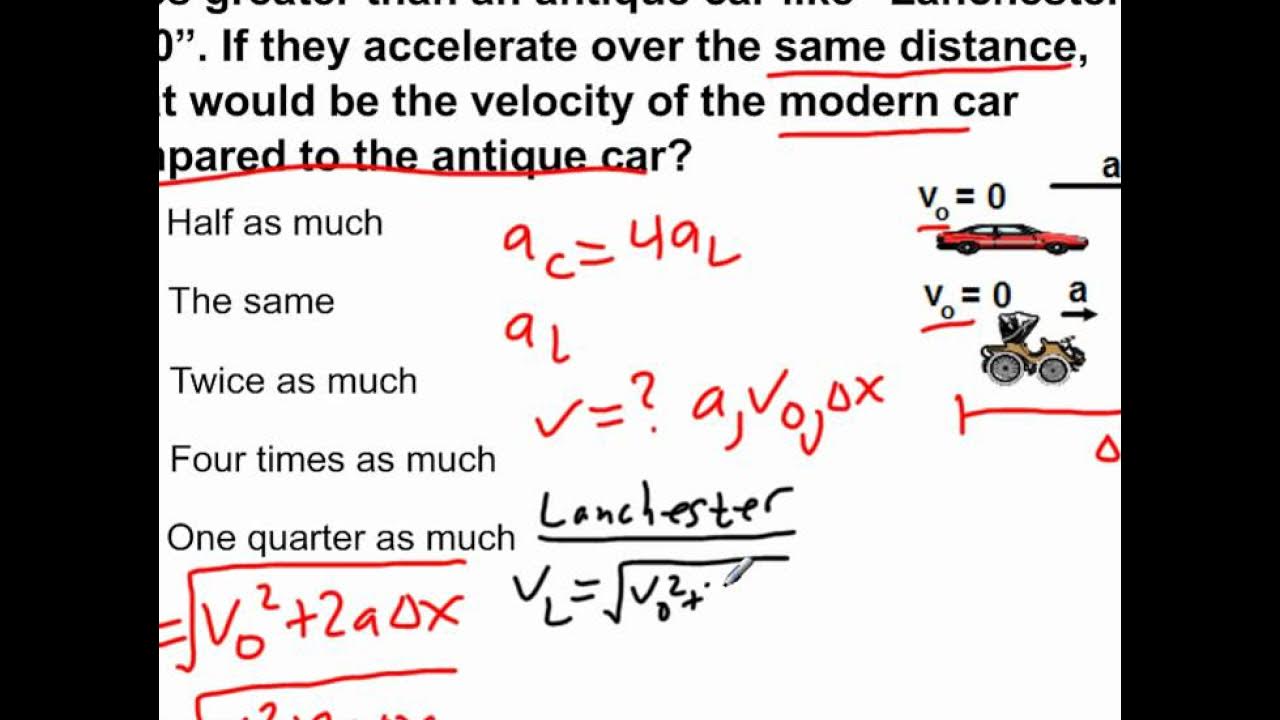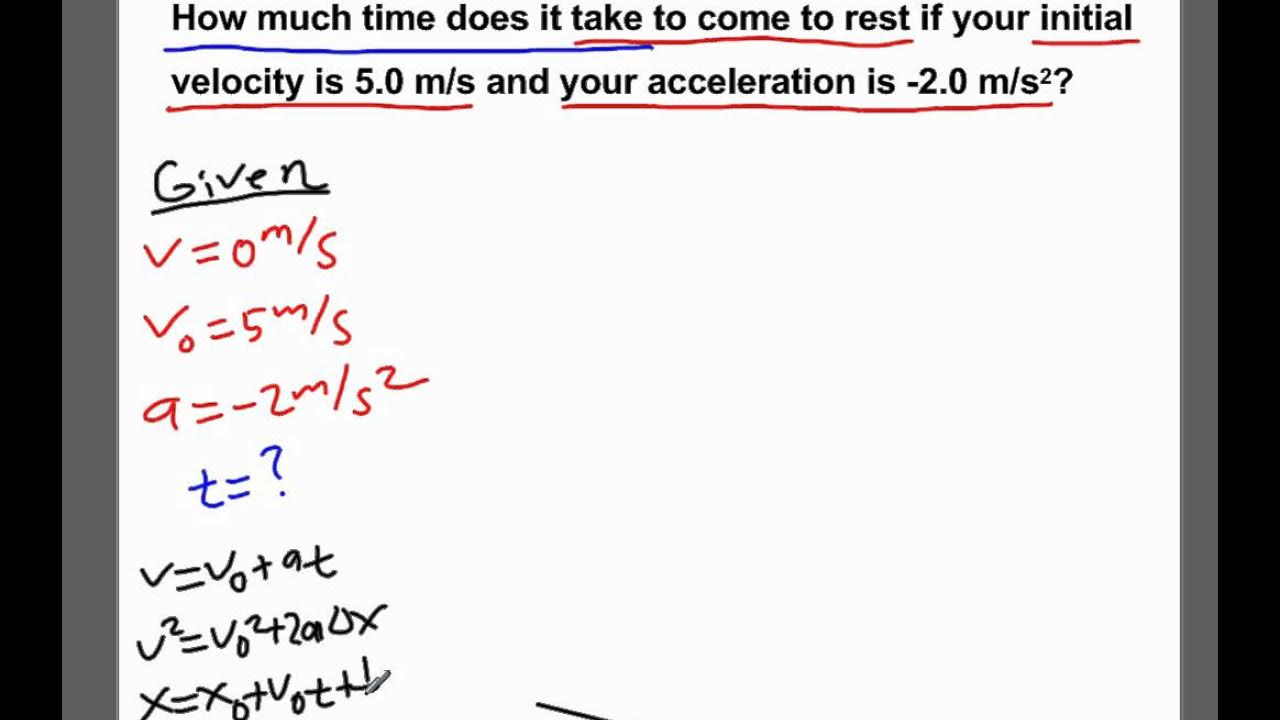How to Derive the Equations of Motion (Derivation)
TLDRThis script provides a detailed derivation of three fundamental equations in kinematics. It starts by explaining how acceleration, the rate of change of velocity, leads to the equation v = u + at. It then derives the displacement equation, s = ut + (1/2)at^2, using the concept of average velocity. Finally, it derives the equation v^2 = u^2 + 2as by squaring the first equation and substituting the displacement formula, showcasing the relationship between initial velocity, acceleration, and displacement.
Takeaways
- 📐 Acceleration is defined as the rate of change of velocity.
- 🔄 Acceleration (a) can be expressed as the change in velocity (v - u) divided by time (t).
- 🔧 Rearranging the formula, v = u + at.
- 📏 Average velocity (v_avg) is the sum of initial velocity (u) and final velocity (v) divided by two.
- 🔄 Substituting v = u + at into the average velocity formula gives v_avg = (u + u + at) / 2.
- 📉 Velocity is displacement (s) over time (t), thus s/t = (2u + at) / 2.
- 📊 Multiplying both sides by t, s = ut + 0.5at^2.
- 🔄 To derive v^2 = u^2 + 2as, start with v = u + at and square both sides.
- 🔍 Squaring both sides yields v^2 = u^2 + 2uat + a^2t^2.
- ➗ Factor out 2a from the expression, using s = ut + 0.5at^2, resulting in v^2 = u^2 + 2as.
Q & A
What is the initial step in deriving the equation v = u + at?
-The initial step is to recognize that acceleration (a) is the rate of change of velocity.
How is acceleration expressed in terms of initial and final velocity?
-Acceleration is expressed as a = (v - u) / t, where v is the final velocity and u is the initial velocity.
What algebraic step is performed to isolate v in the equation a = (v - u) / t?
-Multiply both sides by t to get at = v - u, then rearrange to solve for v, giving v = u + at.
How do you define average velocity in the context of deriving the equation s = ut + 1/2 at^2?
-Average velocity (v_avg) is defined as (u + v) / 2, where u is the initial velocity and v is the final velocity.
How is the equation v = u + at used in the derivation of s = ut + 1/2 at^2?
-The equation v = u + at is substituted into the average velocity equation, making v_avg = (u + (u + at)) / 2.
What substitution is made to incorporate displacement into the derivation of s = ut + 1/2 at^2?
-Displacement (s) is substituted as s = v_avg * t, leading to s = t * ((2u + at) / 2).
What is the final simplified form of the equation s = ut + 1/2 at^2 derived from?
-After simplifying and dividing, the final form is s = ut + 1/2 at^2.
What initial equation is used in the derivation of v^2 = u^2 + 2as?
-The initial equation used is v = u + at.
What step is taken to derive v^2 = u^2 + 2as from v = u + at?
-Both sides of the equation v = u + at are squared, resulting in v^2 = u^2 + 2uat + a^2t^2.
How is the term s = ut + 1/2 at^2 used in the final step of deriving v^2 = u^2 + 2as?
-The term s = ut + 1/2 at^2 is substituted back into the equation to simplify and obtain v^2 = u^2 + 2as.
Outlines
📚 Derivation of Velocity Equation
This paragraph explains the derivation of the basic equation of motion, v = u + at, where 'v' is the final velocity, 'u' is the initial velocity, 'a' is the acceleration, and 't' is the time. It begins by defining acceleration as the rate of change of velocity. The change in velocity is expressed as the final velocity minus the initial velocity, divided by time, leading to the equation a = (v - u) / t. By rearranging, the formula for final velocity is obtained as v = u + at.
📘 Derivation of Displacement Equation
The second paragraph focuses on deriving the equation for displacement, s = ut + (1/2)at^2. It starts by calculating the average velocity, v_avg = (u + v) / 2, and substitutes the previously derived velocity equation, v = u + at, to find v_avg in terms of initial velocity and acceleration. The displacement is then related to average velocity and time, leading to the equation s = ut + (1/2)at^2 after simplification.
📙 Derivation of the Kinematic Equation for v^2
The final paragraph derives the kinematic equation relating the square of the final velocity to the initial velocity and displacement, v^2 = u^2 + 2as. It begins with the equation v = u + at and squares both sides to obtain v^2 = u^2 + 2ut + at^2. Recognizing that ut + (1/2)at^2 equals the displacement 's', the equation is simplified to v^2 = u^2 + 2as, which is the desired result.
Mindmap
Keywords
💡acceleration
💡velocity
💡initial velocity (u)
💡final velocity (v)
💡time (t)
💡displacement (s)
💡average velocity
💡squaring
💡equation derivation
💡rate of change
Highlights
Derivation of the equation v = u + at, starting with the concept that acceleration is the rate of change of velocity.
Acceleration defined as the change in velocity over time, leading to the rearrangement of the formula to isolate v.
Introduction of the average velocity concept in the derivation of s = ut + (1/2)at^2.
Substitution of the derived velocity equation into the average velocity formula.
Relating velocity to displacement over time to derive the displacement equation.
Manipulation of the displacement equation to express s in terms of u, a, and t.
Derivation of the final displacement equation s = ut + (1/2)at^2 by simplifying the terms.
Derivation of the equation v^2 = u^2 + 2as starting from the initial velocity equation.
Squaring both sides of the initial velocity equation to progress towards the final form.
Introduction of the factorization technique to simplify the squared velocity equation.
Substitution of the displacement equation into the squared velocity equation.
Final derivation of the equation v^2 = u^2 + 2as, confirming the initial request.
Use of algebraic manipulation to isolate and rearrange terms in the equations.
The importance of understanding the relationship between initial and final velocities in kinematic equations.
Transcripts
5.0 / 5 (0 votes)
Thanks for rating:





